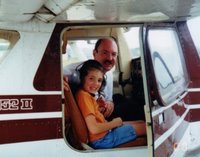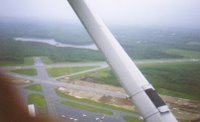
 I did it! I soloed in a Cessna 152 (N67661) today (7-29-00) at Worcester (MA) airport, where I resumed my flight lessons with a new instructor in early June. Worcester Airport (ORH) is only 20 minutes from home and is a tower-controlled airport with light airline traffic. I now have a whopping zero-point-five hours as pilot in command. The weather was the usual for Worcester -- cloudy, wanting to rain. Last Sunday we did a "final" test -- 6 landings with no help from my instructor. I did well, so we scheduled a long block of time for Saturday, expecting to solo. I arrived early and spent over an hour with my CFI, Mario, going over my pre-solo written test. That was pretty easy thanks to all the ground school study. Meanwhile, I'm sweating the weather, since ORH started the day with fog and 100 foot ceilings. By 11:30 a.m. it was up to 1100 feet, but we need 1500 to meet minimum VFR (500 feet below any clouds, and pattern altitude is 1000 ft AGL, 2000 ft MSL -- visibility was fine, 10 miles).
I did it! I soloed in a Cessna 152 (N67661) today (7-29-00) at Worcester (MA) airport, where I resumed my flight lessons with a new instructor in early June. Worcester Airport (ORH) is only 20 minutes from home and is a tower-controlled airport with light airline traffic. I now have a whopping zero-point-five hours as pilot in command. The weather was the usual for Worcester -- cloudy, wanting to rain. Last Sunday we did a "final" test -- 6 landings with no help from my instructor. I did well, so we scheduled a long block of time for Saturday, expecting to solo. I arrived early and spent over an hour with my CFI, Mario, going over my pre-solo written test. That was pretty easy thanks to all the ground school study. Meanwhile, I'm sweating the weather, since ORH started the day with fog and 100 foot ceilings. By 11:30 a.m. it was up to 1100 feet, but we need 1500 to meet minimum VFR (500 feet below any clouds, and pattern altitude is 1000 ft AGL, 2000 ft MSL -- visibility was fine, 10 miles). By 12:30 it had crept up to 1500 so we decided to try it -- winds were calm to 6 knots and mostly west, little crosswind (only runway 29/11 is open due to construction on 33/15). We took off a little after 1 pm (after a careful pre-flight -- Betty and Caroline had also just arrived to see me off and take pictures -- I sent them down to the approach end of runway 29). We didn't expect to have much time, since a thunderstorm was expected later in the afternoon, and as that moved in, wind and wind-shear could be a problem. One odd thing was that the ATIS frequency was off the air for some reason, so I had to telephone for the pre-flight ATIS info. The tower frequency was a bit scratchy too -- I was glad I reviewed the light gun signals, though I didn't need them.
Mario once again was deliberately silent (and hands off), and I did two pretty decent touch-and-goes. The third was to be full-stop, but I flared WAY too high, bounced a lot and drifted to the right, so he said "let's see that one again." I took it around the pattern and landed OK. We taxied back to Amity, and I left the engine running while Mario gave me some final words and hopped out (he had already signed my logbook and student certificate). His main advice was "no pressure - don't rush for ANYBODY." I got a little stressed last lesson when we were sandwiched between two turboprop commuters and two Pipers in the run-up area. Follow procedures and ATC instructions, but don't rush and forget things!
Once he was out, it seemed very..... routine! I consciously looked down at the empty seat, said "that's odd," finished my checklist, and called ground for permission to taxi. Just following procedures. When I called the tower at the intersection of taxiway bravo and runway 29, I was told to hold short while another small plane landed (a Mooney I think -- I had seen him on base and final so I expected this). This gave me a minute to look for Betty and Caroline -- they were at the fence and Betty waved back to me. Then I got "taxi into position and hold" followed shortly by "clear for takeoff, make left closed traffic." So I took off. This didn't feel the least bit scary or odd to me, though as I expected, the C152 climbs a lot better with only one person aboard! I got maybe 1000 fpm rather than 500 or less with Mario aboard. I was careful to watch my airspeed and to stay coordinated. I remembered carb heat, radio calls midfield downwind, power reduction, and all stages of flaps. I was not as consistent on my turns to base and final as I wanted to be, and I overshot the first one a lot (shallow S-turn back to line up, keeping the ball centered pretty well), the second one a bit, but the third was just right. I picked my landing spots each time, but didn't really stick with the decision (I added a bit of power when I felt like I was getting low a couple of times, though the VASI lights generally showed me as high -- of course high is better than low).
The first landing was a bit "firm" but OK, and I kept good control as I rolled out, raised flaps, killed carb heat, and applied full power for the touch-and-go. The second landing seemed smoother, though it was long because I started to flare very slightly when I was still a bit high (hey, I got 7000 feet of runway to play with). The third landing was full-stop, and I think the flare was good, but when the nose wheel came down, it started shaking like crazy. I pulled back gingerly on the yoke (offload the nose wheel, aerodynamic braking) while I also applied the brakes pretty hard, wanting to exit at the usual taxiway delta. The tower told me to take that exit and contact ground. I switched to 123.85 and reported "Worcester ground, Cessna 67661, clear of the active." They told me to taxi to Amity, so I did. No special words from the tower (I hadn't mentioned first solo to them, though Mario had called them on the phone to let them know to watch out for me). But when I taxied back, Mario was there with a big grin and a Polaroid camera. He said I did a great job. Betty and Caroline showed up a moment later and we took more pictures. It was only three landings, 0.5 hours in my logbook (plus 0.7 more dual), but this was my first solo flight, first PIC time, so it's really REALLY cool.
Now I know I can finish my private pilot, hopefully this year -- sure, I still have a lot to learn, but that first solo is really a confidence builder after decades of dreaming and three years of start-and-stop lessons. In each of the last three springs and summers, I managed to get 6 or 8 hours in, then something would come up (the first "something" was a divorce!). Things have stabilized pretty well now, and I realized in June that this is the one thing I have consistently wanted to do for some 35 years, since first learning the basics of flight in a bunch of Piper Cub orientation flights as a Civil Air Patrol cadet. So I decided I would not put it off any longer. Lifelong dreams are too important!
This is the "solo story" that I posted in rec.aviation.students.
Time: 0.7 dual, 0.5 solo, TT 28.9/0.5 hrs, C152 at ORH

